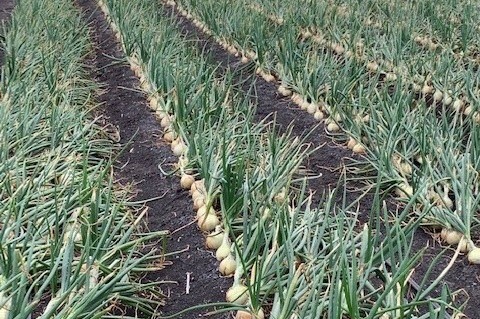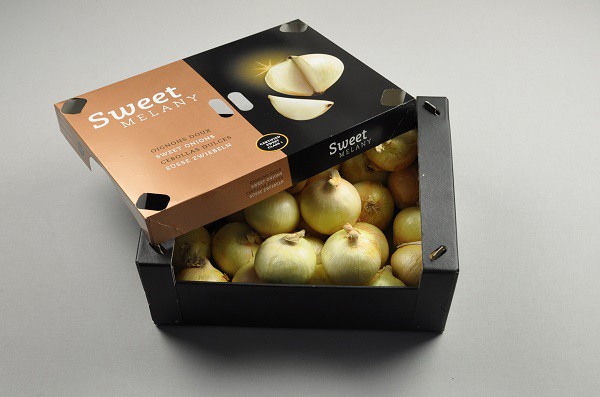Sweet onions are the perfect niche product. They're expensive because they're better and scarcer. And a select group of people love them. Since sweet onions have a similar shelf life to standard yellow onions, better refers to their flavor. There is no disputing this - "once you've tasted a sweet onion, you'll be back", says Joost de Jong, buyer at Gourmet. This Dutch company specializes in the cultivation and year-round marketing of shallots, onions, and garlic.

Sweet onions are mostly short-day onions and do not grow in the Netherlands. They do in Spain, though. For example, BASF's Caramelo and NUN 1006 varieties thrive in Andalusian fields in the South of Spain. They are available there from the end of April. The same seed house also recently introduced Sunions there, an onion that has been doing well in the U.S. for several years.
"Other storage onions' flavor becomes sharper over time, Sunions become sweeter. These are even stored for a certain time before being marketed to guarantee that characteristic," is how BASF Spain puts it. It is the "first onion that doesn't make you cry when you slice it." This improved storability is no doubt due to these being "a long day onion, harvested from July through September," states this company.
A little further north, near Zaragoza, still in Spain, you will find onions like the protected designation of origin (PDO) Fuente de Ebro. "They have such a high water content; they caramelize immediately when you fry it," say the folks at Jumosol, the Spanish company that sells this onion from July to December.

In August, 2,500 tons of PDO onions are harvested in about 30 villages in Cevennes, southern France. Those are stored until March. "But we don't get anything from France," says Joost. "We source our products from Spain, Peru, and Mexico. We have a year-round supply of those."
Peru is undoubtedly a major producer of this type of onion. Annually, it exports more than 150,000 tons of sweet onion, 90% to the United States. Neighboring countries and the European market buy the rest. Sweet onions are more popular in the U.S. than in Europe. After the Peruvian season, America switches there to Mexican onions and then to domestic production, mainly from Georgia.
“We work with cultivation contracts in Spain," Joost explains. "The first volumes arrive around May-June, and with some luck, we make it through until late November when the quality deteriorates slightly. We begin with Peru in October/November already. On April 1st, we switch to Mexico until there are Spanish sweet onions again. We don't get these from the U.S.; they don't arrive with the correct quality. Sweet onion's trump card is their flavor."
"But because of its limited shelf life - with skin as thin as tissue paper, high moisture content, and no post-harvest treatment with things like sprout inhibitors - it remains a small item. We can't do large volumes of it. If turnover rates aren't guaranteed, some supermarkets won't stock onions with only a three-week shelf life. But the stores that do have them usually have a set sales pattern. Some of our customers buy five tons every week. They definitely have some clients who keep returning for these onions."
According to De Jong, consumption has remained stable for years, with roughly equal summer and winter sales. Demand is not growing yet. "Of course, the pandemic has shaken up consumption patterns. Shoppers return to the basics, after all." However, sweet corn and avocado were already big in America while still small in Europe. So, sweet onions could still become wildly popular.
Gourmet prefers getting its products from European farms. That may be even more true for sweet onions because transit time-wise, sourcing from Spain versus Peru makes a difference. "I prefer everything from Europe, but obviously, that's not possible." The labor shortage is another challenge for sweet onions, as it is with all products. To make things worse, you have to harvest sweet onions manually. Spanish, like Dutch horticulture, is struggling to find enough workers.
"Last year, they suddenly had to harvest both onions and garlic. So everyone went for garlic," recalls Joost. Labor is cheaper in Africa, so Morocco inevitably comes into the picture. "Morocco, indeed, already grows sweet onions, and there have been projects in Senegal. But, those products still have to meet European supermarket specifications and have the right export certificates," he concludes. Gourmet markets its sweet onions in 5kg boxes for the hospitality industry and various small packages for retailers.
Joost de Jong Gourmet
Gourmet
Slimweg 42
1614 MG Grootebroek
Nederland
+31 (0)228 517 386
joost@gourmet.nl
